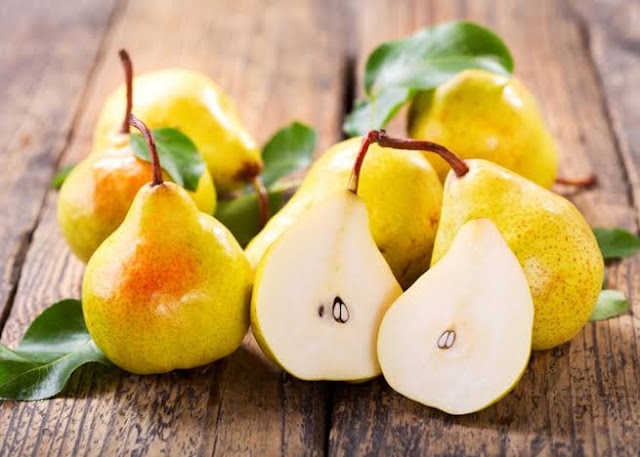Pear Fruit/Nashpathi🍐- Health benefits, application, chemical constituents, side effects and many more
Pear Fruit/Nashpathi
Pear is a gently sweet juicy fruitwith glitter and buttery texture. It holds 2nd rank after apple innutrition amongst cultivated fruits. Ancient Greek poet Homer narrated Pears as one of the ‘gifts of God’. Pear belongs todicotyledonous plant species of genus pyrus, (family Rosaceae).In Sanskrit, it is named as ‘Amritphale’ because of its immense potential in human health care. Its varieties are widely distributed all over the world, which may be ‘stiff’(Nashpati) or soft’(Babbu-ghosh). Pears can be classified in to three categories based upon their origin and commercial production viz. i) European Pear ( Pyrus communis L.), ii) Japanese Pear ( P. pyrifolia Burm.) and iii) Chinese Pear (P. bretschneideriRehd.and P. ussuriensis Maxim).
It shows anti-inflammatory, sedative, anti-pyretic, anti-oxidant, hypolipidemic, hypoglycaemic, anti-aging, analgesic,spasmolytic, anti-tussive, anti-diarrheal, wound healing, anti-microbial and hepato-protective properties.
Click here to explore more about Antioxidant and Free radicals
It has different names in different languages such as Sanskrit Name(Nashpathi), Marathi Name(Naspathi), English Na............................read more
Vitamin and Mineral content
Vitamin : C, E, K B1, B2, B3, B5, B6, B8
Minerals : Calcium, Iron, Magnesium Phosphorus, Manganese, Potassium, Sodium, Zinc
Pears are particularly rich in fructose and sorbitol, as compared with other fruits. Although most fruits contain sucrose, pears and apples contain 70% fructose.
Pears contain 4.5% fructose, 4.2% glucose, 2.5% sucrose, and 2.5% sorbitol.
Pears contain 71% insoluble fiber and 29% soluble fiber.
Lignins are the noncarbohydrate part of dietary fiber and are generally linked to wheat bran and cereal fibers. Lignins in plants are biotransformed into lign............................read more
Properties and Benefits
- Taste – Sweet
- Virya(potency) – cold(shitala)
- Taste conversation after digestion - Sweet(Madhura)
- Laghu – light for dig............................read more
- Effect on Tridoshas – Balances all three doshas
Click here to explore more information about Tridosha (vata-Kapha-Pitta)
Uses, Remedies, Benefits and Application
1) Leaves and bark is used in wound healing. It acts as anti inflammatory.
- pear can be useful in treating inflammation of mucous membranes, colon, chronic gall-bladder disorders, arthritis and gout. Carotene, zeaxanthin and vitamin C are nutrients presentabundantly in Pear, which lower the concentration of inflammation - causing C-reactive proteins.
2) Flowers are used as components of pain relieving and spasmolytic drugs.
3) For High cholesterol, Eat stewed pears spiced with cinnamon to lower cholesterol.
- Pears have high content of pectin, which lowers down levels ofLDL, triglycerides & VLDL thereby reducing risk of high cholesterol.
Click here to explore more about Cinnamon
4) In summer heat may cause children to have shortness of breath with excessive phlegm. Drinking of Pear juice during summershelps in clearing the phlegm. It reduces vocal cordinflammation, nourishes the throat and helps prevent throat problems.
5) Eating Pear regularly helps to manage constipation as it has high dietary fibers. Due to low calories and vitamin C content, it helps in weight management and boosts immunity.
6) Fruits as a good source of pectin maintains the desirable acid balance in the body.
7) Due to the low sucrose content of pear, it is recommended in diabetic patients.
- fruit contains high amount of fiber, which maintains bloodglucose levels in diabetics. Furthermore, levulose, low fructoseand low sucrose fruit sugars are well tolerated by diabetic patients.
8) Plant extract controls freckles and blemishes on the skin. It prevents the formation of melanin and used in skin lightening. Arbutin content present in plant is used as skin whitening agent and in urinary therapeutics.
9) According to Ayurveda, people having weak digestion should avoid over consumption of Pear as it takes longer time to digest due to its Guru (heavy) nature.
10) Pears mainta............................read more
Note :
- Pear never ripens on the tree, but it ripens off the tree.Pears will ripen quicker if you place them by the side of bananas but its life span would be enhanced, when placed in refrigerator.
- Comparisons of apples and pears find that pears are higher in fructose and sorbitol, whereas apples are higher in glucose and sucrose.
- The skin of Pear cont............................read more
If you want to give more suggestion in this, then comment us, we will replay your comment.
If you like this post, then share it and follow us on Instagram (@healthyeats793) and many thanks for coming to our site Healthy eats
keep visiting
Support us
3) Facebook
4) Pinterest
🙏🙏Subscribe and share for latest updates 🙏🙏
More posts from our site
- Click here for more information about Tamarind
- Click here for more information about Nutmeg (Jaiphal)
- Click here for more information about Viruddha aahra
- Click here for more information about Jambul (java phalam)
- Click here for more information about Marking nut (bibba)
- Click here for more Home remedies of Nirgundi
- Click here for more information about saffron
- Click here for more information about Elephant foot/Yam
- Click here for more information about Watermelon 🍉🍉
- Click here for more information about Jackfruit/phanus
- Click here for more information about summer care 🌞
Refrence:
- Int. J. Res. Ayurveda Pharm. 7(Suppl 1), Jan - Feb 2016
- Journal of Ethnic Foods. Volume 2, Issue 3, September 2015, Pages 97-109
- Nutr Today. 2015 Nov; 50(6): 301–305. Published online 2015 Nov 23. PMCID: PMC4657810
- BMC Complement Med Ther. 2021; 21: 219. PMCID: PMC8409479
- Molecules. 2020 Oct; 25(19): 4444. PMCID: PMC7582546
- Local tradition and knowledge
- WORLD JOURNAL OF PHARMACEUTICAL AND MEDICAL RESEARCH, 2019,5(3), 204-214
- African Journal of Food Science and Technology (ISSN: 2141-5455) Vol. 1(3) pp. 076-81, September, 2010
- NCBI
- PUBMED
- The Asian and Australian journal of plant science and biotechnology.2012;6(1):102-107.
- Asian J Pharm Clin Res, Vol 6 Suppl 5, 2013, 108-111109
- BMC Complement Med Ther. 2021;21(1):219.
- Food Funct. 2017;8(3):927-934.
- Genes Nutr. 2018; 13: 29.
- Published online 2018 Nov 29. PMCID: PMC6267079







Comments
Post a Comment